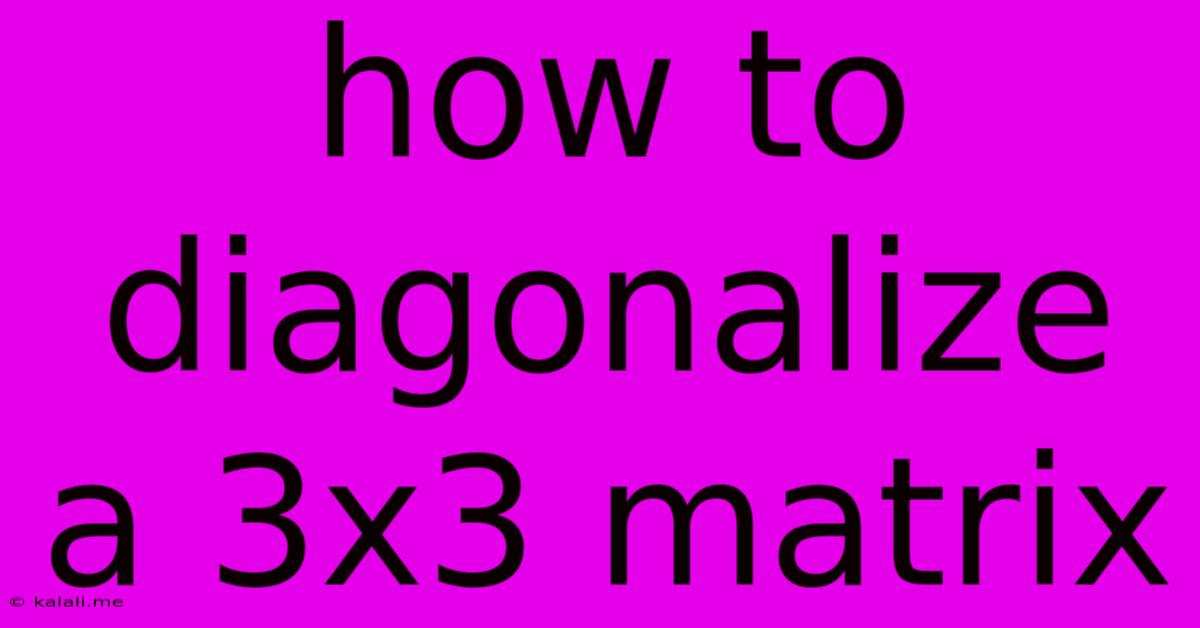How To Diagonalize A 3x3 Matrix
Kalali
May 30, 2025 · 3 min read

Table of Contents
How to Diagonalize a 3x3 Matrix: A Step-by-Step Guide
Diagonalizing a matrix is a crucial process in linear algebra with applications spanning various fields, from physics and engineering to computer science and data analysis. This guide provides a comprehensive walkthrough on how to diagonalize a 3x3 matrix, explaining the underlying concepts and offering a step-by-step approach. Understanding eigenvalues and eigenvectors is fundamental to this process. This article will cover finding those, and ultimately achieving the diagonalized form.
What is Matrix Diagonalization?
Matrix diagonalization involves transforming a square matrix into a diagonal matrix, where all off-diagonal elements are zero. This is achieved by finding a change of basis represented by a matrix P, such that P⁻¹AP = D, where A is the original matrix and D is the diagonal matrix containing the eigenvalues of A. The columns of P are the corresponding eigenvectors. Not all matrices are diagonalizable; a matrix is diagonalizable if it has a complete set of linearly independent eigenvectors.
Step 1: Find the Eigenvalues
The eigenvalues (λ) of a matrix A are the solutions to the characteristic equation: det(A - λI) = 0, where I is the identity matrix. For a 3x3 matrix, this results in a cubic equation. Let's illustrate with an example:
Consider the matrix A:
A = | 2 1 1 |
| 1 2 1 |
| 1 1 2 |
- Construct (A - λI):
A - λI = | 2-λ 1 1 |
| 1 2-λ 1 |
| 1 1 2-λ|
-
Calculate the determinant: This involves cofactor expansion or other determinant calculation methods. The resulting characteristic equation for this example is:
(2-λ)((2-λ)² - 1) - (2-λ - 1) + (1 - (2-λ)) = 0
-
Solve the cubic equation: Solving this equation (often using numerical methods for more complex matrices) will yield the eigenvalues λ₁, λ₂, and λ₃. For our example, the eigenvalues are λ₁ = 4, λ₂ = 1, and λ₃ = 1.
Step 2: Find the Eigenvectors
For each eigenvalue λᵢ, solve the system of linear equations (A - λᵢI)vᵢ = 0, where vᵢ is the eigenvector corresponding to λᵢ. This involves Gaussian elimination or similar methods to find the null space of (A - λᵢI).
-
For λ₁ = 4:
(A - 4I)v₁ = 0 leads to the system:
| -2 1 1 | |x| |0| | 1 -2 1 | |y| = |0| | 1 1 -2 | |z| |0|Solving this system gives an eigenvector v₁ = (1, 1, 1).
-
For λ₂ = 1:
(A - I)v₂ = 0 leads to:
| 1 1 1 | |x| |0| | 1 1 1 | |y| = |0| | 1 1 1 | |z| |0|This system has two linearly independent solutions, for example v₂ = (-1, 1, 0) and v₃ = (-1, 0, 1).
Step 3: Construct the Diagonal Matrix (D) and the Transformation Matrix (P)
The diagonal matrix D is formed by placing the eigenvalues along its diagonal:
D = | 4 0 0 |
| 0 1 0 |
| 0 0 1 |
The transformation matrix P consists of the eigenvectors as its columns:
P = | 1 -1 -1 |
| 1 1 0 |
| 1 0 1 |
Step 4: Verify the Diagonalization
To verify, compute P⁻¹AP. If the result is equal to D, then the diagonalization is correct. This step involves finding the inverse of P (using methods like Gaussian elimination or adjugate matrix calculation) and performing matrix multiplication.
Conclusion:
Diagonalizing a 3x3 matrix is a systematic process involving finding eigenvalues and their corresponding eigenvectors. While the calculations can be computationally intensive, understanding the underlying concepts and utilizing appropriate techniques allows for efficient and accurate diagonalization. Remember that not all matrices are diagonalizable; the existence of a complete set of linearly independent eigenvectors is crucial for this process to succeed. This process has significant applications in various mathematical and scientific fields.
Latest Posts
Latest Posts
-
How Much Spaghetti Sauce For 150 People
May 31, 2025
-
How To Fix Flickering Led Lights
May 31, 2025
-
How To Not Get Shocked By Static
May 31, 2025
-
Not By Might Nor By Power Scripture
May 31, 2025
-
How Do You Make A Grid In Photoshop
May 31, 2025
Related Post
Thank you for visiting our website which covers about How To Diagonalize A 3x3 Matrix . We hope the information provided has been useful to you. Feel free to contact us if you have any questions or need further assistance. See you next time and don't miss to bookmark.